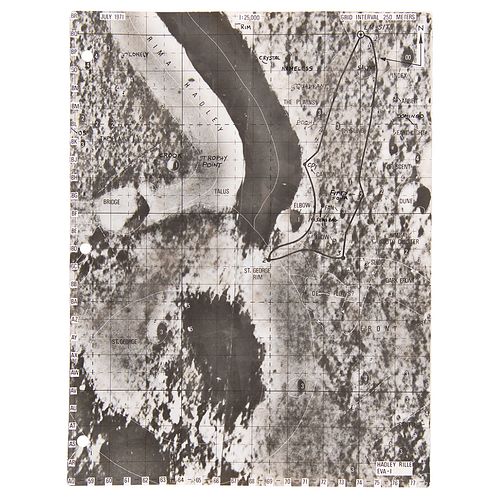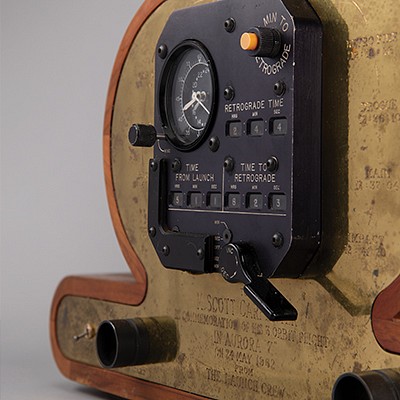Apollo 15 Lunar Surface-Used LRV Photo Map - From the Personal Collection of Dave Scott
Two ways to bid:
- Leave a max absentee bid and the platform will bid on your behalf up to your maximum bid during the live auction.
- Bid live during the auction and your bids will be submitted real-time to the auctioneer.
Bid Increments
| Price | Bid Increment |
|---|---|
| $0 | $5 |
| $50 | $10 |
| $200 | $25 |
| $500 | $50 |
About Auction
Oct 19, 2023
RR Auction support@rrauction.com
- Lot Description
Remarkable lunar map used on the surface of the moon during the first EVA of Apollo 15—marking the debut of the Lunar Roving Vehicle (LRV)—labeled “Hadley Rille, EVA-I,” one page, 8 x 10.5, signed and flight-certified on the reverse in black felt tip, “This map was used aboard Lunar Rover #1 during Apollo 15, July 26-Aug 7, 1971. Dave Scott, Apollo 15 CDR.” The map traces the course of the first Apollo 15 EVA from the "LM Site" along the Rima Hadley, past Elbow Crater, to the rim of St. George Crater and back—a path covering about 9 km, which took about six and a half hours to complete. Major lunar geological features are indicated, with many of the craters identified by name. The map was clipped to the LRV accessory staff during EVA-1 so as to be readily available for navigational purposes, exposing it to lunar dust and the vacuum of space. In fine condition.
Accompanied by a detailed signed letter of provenance from Dave Scott, in part: "I hereby certify that the Apollo 15 Lunar Rover 'Traverse Map' labeled: 'HADLEY RILLE, EVA-1, JULY 1971' included with this letter was carried aboard Lunar Roving Vehicle #1 (LRV-1) while exploring the surface of the Moon during for three days at the Hadley Apennine site during Apollo 15‰Û_This map was extracted from the Apollo 15 'LM Lunar Surface Maps' book‰Û_These maps contain traces of lunar dust and were exposed to the temperature extremes, radiation, and Solar Wind on the surface of the Moon‰Û_These maps were used for landmark recognition during navigation from the Lunar Module to the exploration stations as well as in an emergency return to the LM in the event the LRV was unable to return for any reason‰Û_During our first LRV drive, we proceeded south into the unknown. This was the first time in history that a motorized vehicle was driven by humans on another celestial body. The performance and characteristics of the vehicle had never been exposed to the lunar surface, nor had humans ever attempted to navigate and guide such a vehicle over a completely unknown surface such as the surface south of the LM. These very general and large-scale maps were the only available methods of visual navigation, and the relatively simple non-redundant LRV navigation system had never been verified on the Moon. Nevertheless, These maps were useful in locating our general position and coordinating the direction and distance from the LM and return. By coordinating with MCC and frequent reference to locations visually as well as on the maps, we were able to cover the routes planned in relative accuracy." - Shipping Info
-
Bidder is liable for shipping and handling and providing accurate information as to shipping or delivery locations and arranging for such. RR Auction is unable to combine purchases from other auctions or affiliates into one package for shipping purposes. Lots won will be shipped in a commercially reasonable time after payment in good funds for the merchandise and the shipping fees are received or credit extended, except when third-party shipment occurs. Bidder agrees that service and handling charges related to shipping items which are not pre-paid may be charged to a credit card on file with RR Auction. Successful international Bidders shall provide written shipping instructions, including specified Customs declarations, to RR Auction for any lots to be delivered outside of the United States. NOTE: Declaration value shall be the item’(s) hammer price and RR Auction shall use the correct harmonized code for the lot. Domestic Bidders on lots designated for third-party shipment must designate the common carrier, accept risk of loss, and prepay shipping costs.
-
- Buyer's Premium



 EUR
EUR CAD
CAD AUD
AUD GBP
GBP MXN
MXN HKD
HKD CNY
CNY MYR
MYR SEK
SEK SGD
SGD CHF
CHF THB
THB
















